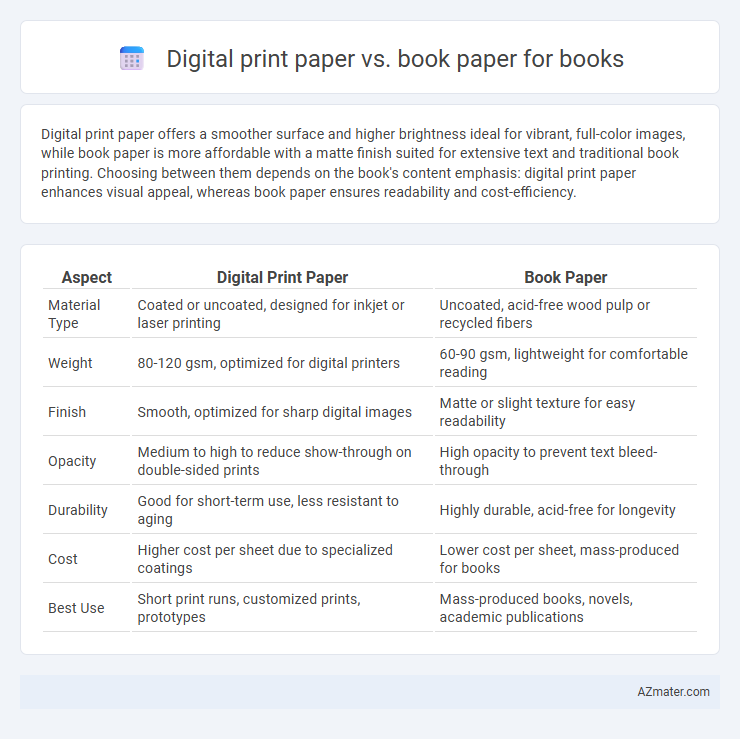Digital print paper offers a smoother surface and higher brightness ideal for vibrant, full-color images, while book paper is more affordable with a matte finish suited for extensive text and traditional book printing. Choosing between them depends on the book's content emphasis: digital print paper enhances visual appeal, whereas book paper ensures readability and cost-efficiency.
Table of Comparison
| Aspect | Digital Print Paper | Book Paper |
|---|---|---|
| Material Type | Coated or uncoated, designed for inkjet or laser printing | Uncoated, acid-free wood pulp or recycled fibers |
| Weight | 80-120 gsm, optimized for digital printers | 60-90 gsm, lightweight for comfortable reading |
| Finish | Smooth, optimized for sharp digital images | Matte or slight texture for easy readability |
| Opacity | Medium to high to reduce show-through on double-sided prints | High opacity to prevent text bleed-through |
| Durability | Good for short-term use, less resistant to aging | Highly durable, acid-free for longevity |
| Cost | Higher cost per sheet due to specialized coatings | Lower cost per sheet, mass-produced for books |
| Best Use | Short print runs, customized prints, prototypes | Mass-produced books, novels, academic publications |
Introduction to Digital Print Paper and Book Paper
Digital print paper is specifically engineered for inkjet and laser printers, offering superior ink absorption and minimal smudging for vibrant, sharp images and text. Book paper, often uncoated and made from wood pulp, provides a smooth texture ideal for traditional offset printing, ensuring durability and readability over extended use. The choice between digital print paper and book paper impacts the print quality, cost, and intended book distribution method.
Composition and Materials of Digital Print Paper
Digital print paper is typically made from a blend of wood pulp and synthetic fibers, enhancing its smoothness and ink absorption for high-resolution printing. This type of paper often features a coated or treated surface to prevent ink smudging and ensure vibrant color reproduction. Compared to traditional book paper, digital print paper's composition prioritizes compatibility with various digital printers and durability under continuous mechanical handling.
Properties and Features of Traditional Book Paper
Traditional book paper, typically made from high-quality wood pulp, offers excellent opacity, durability, and a smooth texture that enhances readability and reduces glare. It has superior ink absorption and minimal bleed-through, which is essential for crisp text and detailed images in printed books. Compared to digital print paper, traditional book paper often provides better archival properties and longevity, making it ideal for publications meant to last.
Print Compatibility and Ink Absorption
Digital print paper features a smooth surface designed for high compatibility with inkjet and laser printers, ensuring sharp image reproduction and minimal ink bleed. Book paper, typically made from wood pulp with a more porous texture, absorbs ink differently, leading to slight feathering but enhancing readability and durability for mass production. The choice between digital print paper and book paper primarily depends on the printing method and desired ink absorption characteristics to achieve optimal print quality.
Color Reproduction and Image Quality
Digital print paper offers superior color reproduction with vibrant, sharp images due to its smooth, coated surface designed for ink absorption and precise detail retention. Book paper, typically uncoated and more porous, often results in muted colors and less crisp images, making it less ideal for high-quality photo or color-intensive content. Choosing digital print paper enhances image quality and color fidelity, crucial for visually rich books like art catalogs or photo collections.
Durability and Longevity Comparisons
Digital print paper typically features smoother coatings and thinner fibers, resulting in reduced durability and shorter lifespan compared to traditional book paper. Book paper, often made from acid-free, lignin-free fibers, resists yellowing and degradation, ensuring superior longevity suitable for archival-quality books. Durability in book paper supports repeated handling and exposure to environmental factors, while digital print paper excels in color vibrancy but may deteriorate faster over time.
Cost Factors and Budget Considerations
Digital print paper typically incurs higher per-unit costs due to smaller print runs and specialized inks, impacting overall book production budgets. Book paper, optimized for offset printing, offers lower costs in large volumes, making it more budget-friendly for extensive print orders. Choosing between digital print paper and book paper hinges on balancing print quantity, quality demands, and budget constraints to optimize cost efficiency.
Environmental Impact and Sustainability
Digital print paper often uses uncoated or lightweight materials that can be recycled more easily, reducing waste in book production. Book paper typically involves traditional pulping processes that consume more water and energy, contributing to a higher carbon footprint. Choosing FSC-certified or recycled digital print paper enhances sustainability by minimizing deforestation and promoting eco-friendly forestry practices.
Reader Experience: Texture and Finish
Digital print paper offers a smooth, consistent texture that enhances the clarity of images and text, providing a modern reading experience ideal for vibrant colors and sharp details. Book paper, often made from uncoated fibers, delivers a tactile, matte finish that reduces glare and is gentle on the eyes, promoting prolonged reading comfort and a traditional feel. The choice between digital print paper and book paper directly impacts the reader's sensory engagement, influencing both visual appeal and physical touch.
Choosing the Right Paper for Your Book Project
Selecting between digital print paper and book paper hinges on the book's purpose and desired quality. Digital print paper offers efficiency and cost-effectiveness for short runs with vibrant colors and sharp text ideal for photo books or self-publishing. Book paper provides durability and a classic feel through higher opacity and weight, optimizing readability and longevity in traditional novels and high-end publications.

Infographic: Digital print paper vs Book paper for Book
 azmater.com
azmater.com